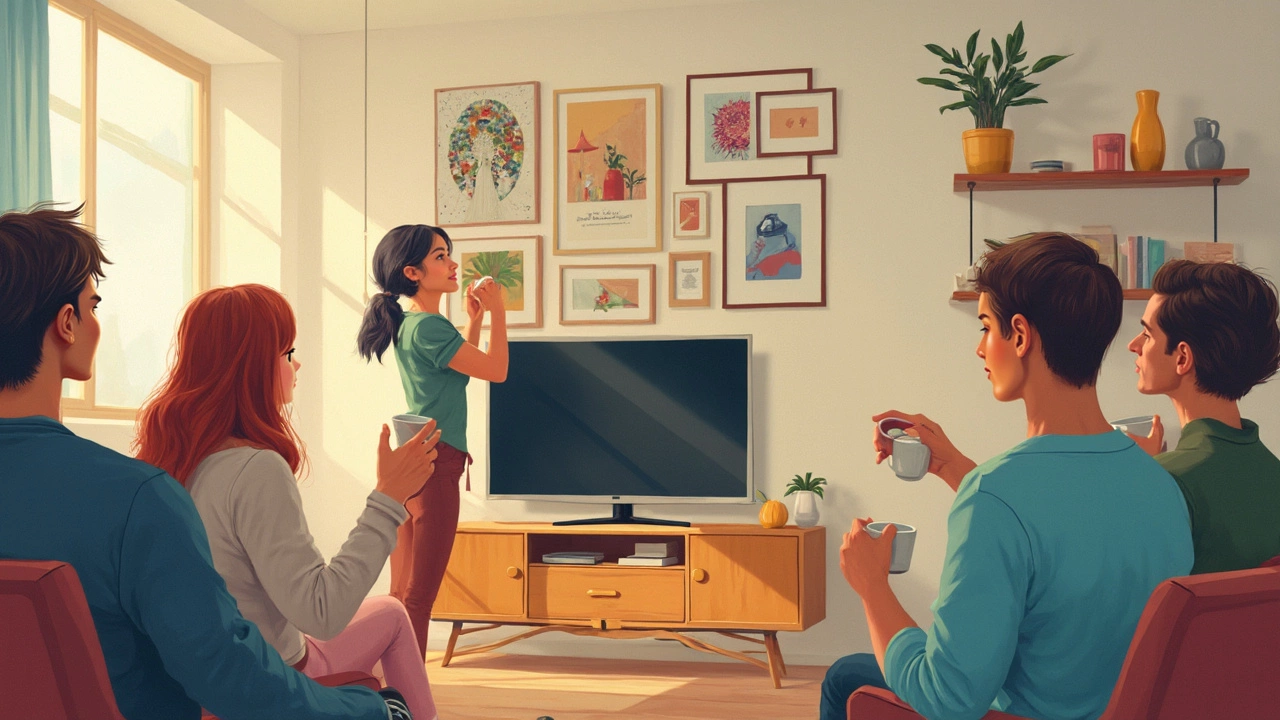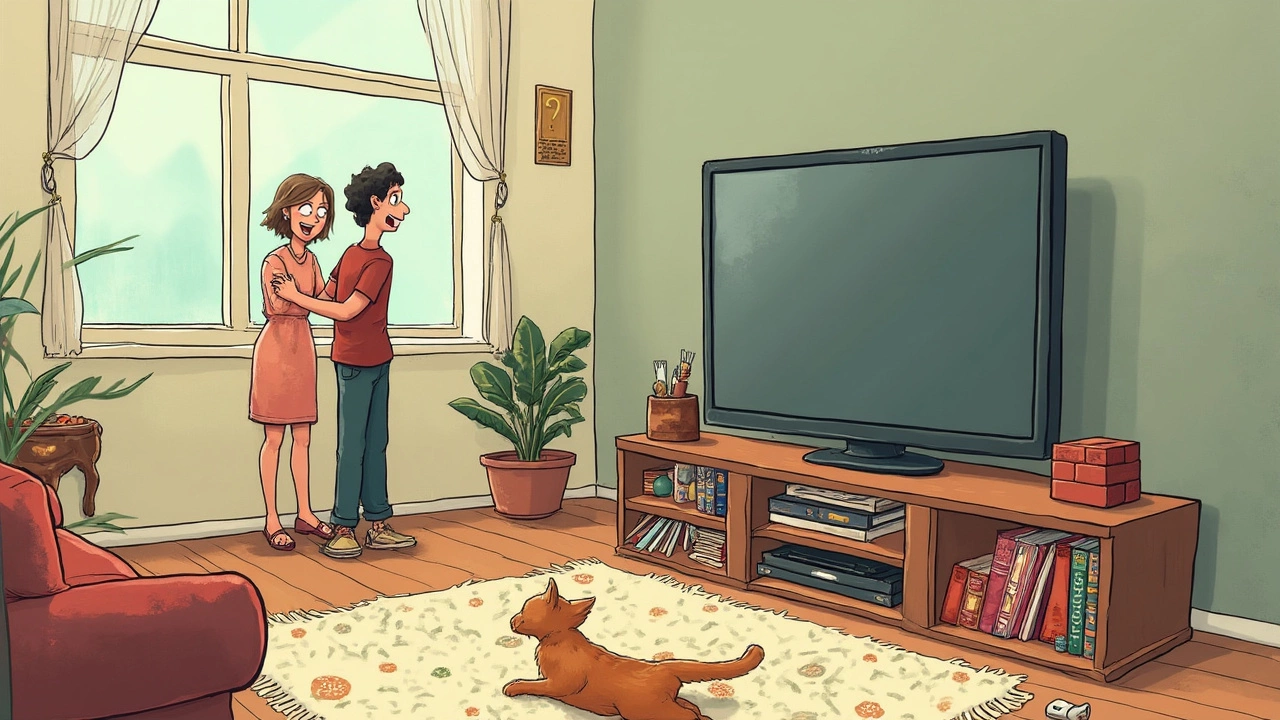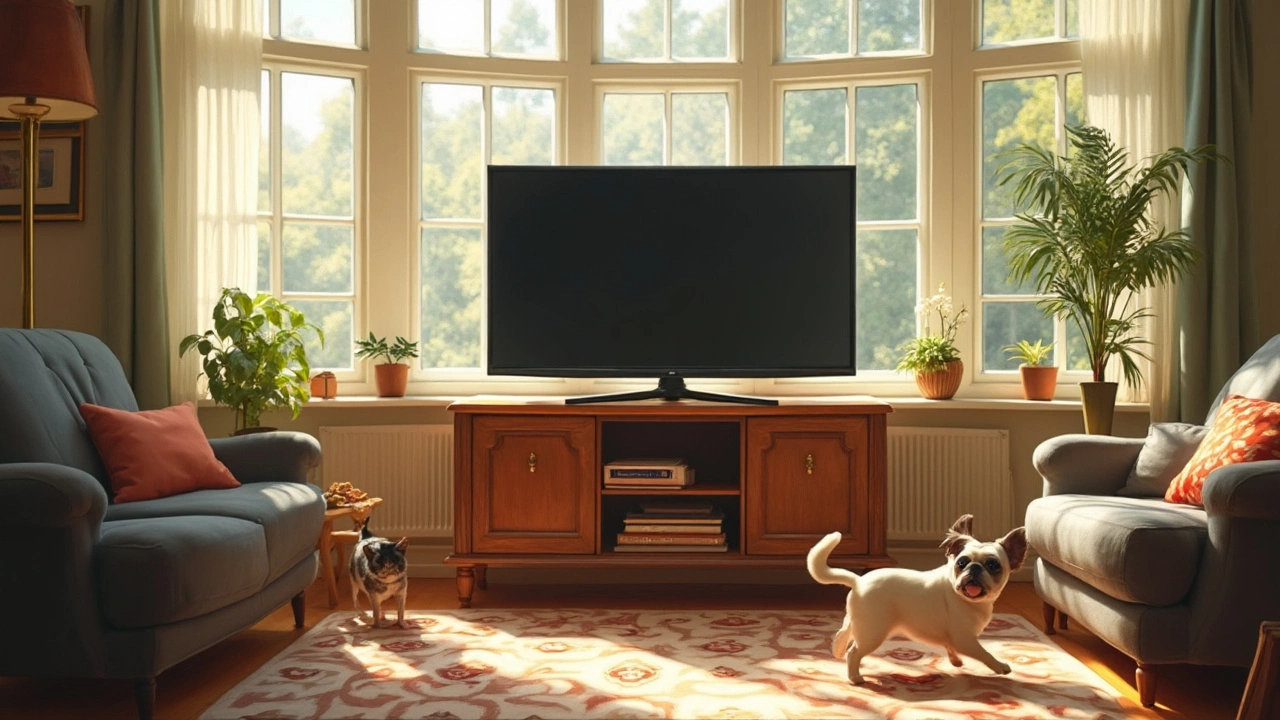Your TV stand is missing, busted, or maybe you just want more space — now what? TVs look fragile, and balance is no joke. With today’s screens (especially big ones), propping it up haphazardly can mess up the ports, or worse, end with a crash. Thankfully, you don't need the original stand to keep your TV upright and safe.
The easiest solution for many folks is using a solid, flat table. Just make sure it’s wide and deep enough so the TV’s weight doesn’t tip it forward or back. If your screen has those awkward feet jutting out, sometimes you can reattach them backwards for a snugger fit in a tight spot — but only if they screw in tight and don’t mess with the balance. No stand at all? Put big, grippy rubber pads or thick foam under each corner. That keeps the TV from sliding every time Luna the cat jumps up or Milo’s tail comes wagging through.
- Testing Tabletop Support Methods
- Wall Mounting: Benefits and How-To
- Using Furniture and Brackets
- DIY Solutions on a Budget
- What Not to Do (And Why It Matters)
Testing Tabletop Support Methods
Before you mark out wall mounts or drills, you might want to support your TV on a table or console. The key? Stability. Modern flat screens, especially the big ones, can be surprisingly top-heavy. Even a slight nudge—trust me, Milo once found out—can send it wobbling. So you’ve got to test before you settle in for movie night.
First, double-check that your chosen surface is wide enough. For example, a 55-inch TV usually needs a table that's at least 48 inches wide so the edges don’t hang off. Here’s a simple check: place the TV base on the surface, and give it a light bump from the back and sides. If it slides or wobbles, it’s not safe.
If your TV’s original feet are missing, try these easy fixes:
- Use heavy-duty rubber pads (like the kind for furniture legs) under each corner. This grips the table and keeps the TV from slipping.
- Folded towels or thin foam mats under each corner can help, but make sure the TV sits flat and isn’t leaning.
- If you have small kids or pets, use adhesive strips (like Command Strips) on the bottom corners of the TV just to add a little more security. They peel off clean if you ever need to move it.
Still feel nervous? Here’s a quick table showing what works for different TV sizes and living situations:
| TV Size | Minimum Table Width | Best for Homes With | Extra Tip |
|---|---|---|---|
| 32" - 40" | 24” | Mostly adults | Rubber pads usually enough |
| 43" - 55" | 48” | Kids or pets | Add adhesive strips for safety |
| 60" and up | 60”+ | Active households | Bungee cord or anti-tip strap recommended |
The most important thing is to make sure the support TV method you pick keeps your screen from tipping over or sliding. Take five minutes to shake and tap your setup—better safe than sorry. You might have to get creative if you’re missing parts, but even a few grippy pads can cut down the risk of a living room disaster.
Wall Mounting: Benefits and How-To
If you’re tired of worrying about your TV toppling over (thank you, rambunctious pets and excited kids), wall mounting is a rock-solid choice. It’s not just about saving space—a wall mount makes the room look cleaner and can actually stop Luna from using the TV as her stage. Plus, many rental apartments allow wall mounts these days, especially if you patch things up before moving out.
Let’s talk perks. By lifting your TV up and out of reach, you help avoid accidental bumps, spills, and falls. According to a 2022 survey by the Consumer Product Safety Commission, over 16,000 U.S. injuries happened that year from TVs tipping over—wall mounting slashes that risk to near zero. You also get more freedom with room layout because you don’t need bulky furniture for your screen.
- Safer for homes with kids or pets
- Frees up floor and table space
- Easier to position the TV at eye level for binge-watching
- Less visible cords if you route them behind the wall
Ready to go for it? Here’s a basic step-by-step on mounting:
- Check your TV’s VESA pattern (those holes on the back for bracket screws).
- Buy a wall mount bracket that matches your TV’s size and weight. Stick with a trusted brand—many shops stock Sanus, Echogear, or Monoprice.
- Find wall studs (a stud finder is your best friend here).
- Mark the bracket holes, drill pilot holes into the studs, and secure the mount tightly. Don’t skip the level—it makes all the difference.
- Attach the mounting arms to the TV, then lift (get a buddy for heavy sets!) and click or screw the TV onto the wall bracket.
Here’s a quick chart for recommended mount types by TV size:
| TV Size | Recommended Mount Type | Typical Weight Limit |
|---|---|---|
| 32"–43" | Tilt or Fixed | Up to 55 lbs |
| 44"–55" | Full-motion, Tilt | Up to 75 lbs |
| 56"–75" | Full-motion | Up to 120 lbs |
Set aside an hour or so for a first-time install. And here’s a tip from a guy whose dog Milo once knocked into the step ladder—lock your pets in another room while you’re working! Double check every bolt before walking away. Support TV the right way, and you’ll enjoy a safer, tidier living space.

Using Furniture and Brackets
If grabbing a support TV wall mount sounds like too much hassle, furniture and brackets are your next best friends. Let’s break down what works and what could wreck your binge-watching plans.
Sturdy furniture makes a big difference. Go for a media console, low dresser, or credenza that’s at least as wide as your TV. Remember, most screens are top heavy; a wobbly table or a piece with uneven legs is an accident waiting to happen—especially if you have kids or big pets. If your TV’s base is smaller than your furniture, get cheap anti-tip kits from any hardware store and strap the back of your TV to the wall or the unit. No drilled holes needed, just sticky pads and tough straps. Retailers like IKEA and Target started bundling these after studies showed up to 33,100 tip-over injuries in the US each year (source: CPSC, 2023).
Brackets come in handy when your TV doesn’t have a proper leg. VESA-compatible brackets let you bolt your TV right to the back of most modern furniture. It’s just four screws and a standard plate—check the back of your TV for holes spaced in a square or rectangle pattern. Most flat screens made after 2010 have this. If you’re missing screws, write down the model and grab them online or at a electronics store.
"Every year, thousands of TVs topple because folks just set them down and hope for the best. Always anchor your TV if you’re not using a dedicated stand or wall mount." — Consumer Reports
Here’s a quick look at what to check:
- Furniture width (must match or exceed TV width)
- Weight rating (your TV’s weight should be under it)
- Bracket compatibility (look for VESA numbers like 200x200 or 400x400 mm)
And here’s how some popular furniture types stack up for safety:
| Furniture Type | Recommended TV Size | Support Level |
|---|---|---|
| Media Console | Up to 85" | Excellent with straps |
| Bookshelf (wide, not tall) | Up to 50" | Good if anchored |
| Dresser | Up to 65" | Good if stable |
| Side Table | Under 40" | Fair — needs extra care |
Don’t just balance a TV on stacked boxes or the edge of a coffee table. One tail swipe from Milo, and you’ll be TV shopping again.
DIY Solutions on a Budget
If you’re not keen on spending extra cash, there are still solid ways to support your TV safely. Sometimes you just need to work with what’s already lying around the house. Just remember, your main goal is to keep the TV steady and upright, not just for looks but to avoid it crashing to the floor. Here’s what actually works:
- Books or Bricks as Risers: Stack thick, sturdy books or bricks underneath each side of the TV, making sure they’re even. Avoid using magazines or anything slippery. This gives the TV a flat base and a little height so it’s easier to see from the couch.
- Anti-Slip Drawer Liners or Rubber Pads: Place a big chunk of drawer liner or a rubber mat right under the TV. This cuts out sliding and doesn't cost much. It’s a lifesaver if you’ve got pets or kids darting around.
- DIY L-Bracket Stands: Grab a pair of L-shaped metal brackets from any hardware store (these usually cost under $5 apiece) and screw them to a solid plank of wood. Then, use the TV’s mounting holes to bolt it down. It’s basic, but it works and doesn’t need fancy tools.
- Velcro Straps or Bungee Cords: Loop heavy-duty Velcro straps or bungee cords around the back of the TV and anchor to the table or furniture. Just make sure it's snug — you don’t want any give when Milo jumps up.
To make things super clear, here’s a quick look at some cheap DIY options and how much they’ll likely cost. These numbers come from Home Depot’s 2024 data for basic materials:
| DIY Solution | Estimated Cost (USD) | Difficulty Level | Main Benefit |
|---|---|---|---|
| Stacked Books/Bricks | $0 - $5 | Very Easy | Uses stuff you already have |
| Anti-Slip Mat | $2 - $7 | Easy | Prevents sliding, super quick |
| L-Bracket Stand | $8 - $15 | Medium | Solid, can handle heavier TVs |
| Velcro/Bungee Cords | $4 - $10 | Easy | Keeps TV steady when bumped |
Pick whatever makes sense for your living room and your budget. If you’re not confident in your DIY skills — especially with large screens — phone a buddy for help and double check that everything’s stable before you binge your next show. When it comes to support TV solutions, it’s all about staying steady and safe, not pretty.

What Not to Do (And Why It Matters)
Trying to support TV without a stand isn’t just about looks—it’s a safety thing. Every year, emergency rooms see thousands of injuries from TVs tipping over. Most of them involve kids or pets bumping into wobbly screens. And let’s be honest, nobody wants a trip to the ER because your TV fell during a heated Mario Kart race or when Milo’s waggy tail did its thing.
Here’s what you definitely should avoid when figuring out how to set up your TV without its original stand:
- Don’t just lean it against the wall: This might look okay for a few seconds, but a slight nudge is all it takes to send it crashing down. Flat screens have high centers of gravity—they’re top-heavy and not designed to be angled against things.
- No stacking on unstable surfaces: Never set your TV on top of wobbly dressers, boxes, or a pile of old magazines. If the base isn’t solid and level, you’re asking for trouble.
- Don’t use tape or makeshift props: Stacking books under one edge or using packaging tape may sound clever, but these quick fixes come apart easily, especially with heat or movement. Tape can also leave sticky marks that are a pain to clean off.
- No DIY wall mounting without the right hardware: Screwing the TV into drywall with random brackets is risky. If you skip proper anchors or bolts, the entire thing can pull away from the wall. Always use mounting kits rated for your TV size and weight.
- Don’t skip cable management: Dangling cords are a tripping hazard, especially if kids or pets are in the mix. A caught cable can yank the TV down in a flash.
Some folks are tempted to rest their TV on kitchen countertops or even the floor. These sound harmless until you realize how easy it is for someone to step on a corner, or spill something into the vents, frying the inside parts for good.
Just to put things in perspective, check out this quick table about TV tip-over accidents in the US, based on Consumer Product Safety Commission data:
| Year | ER Visits (TV Tip-Overs) | Percent Involving Children |
|---|---|---|
| 2022 | 6,800+ | 76% |
| 2023 | 7,100+ | 74% |
If you do things right, you avoid these risks. You also protect your investment—new TVs aren’t cheap, and repairs for a busted screen can cost almost as much as a replacement.


Write a comment